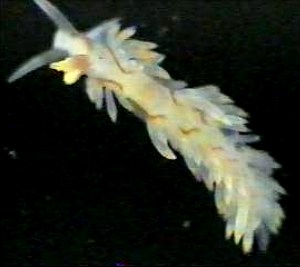
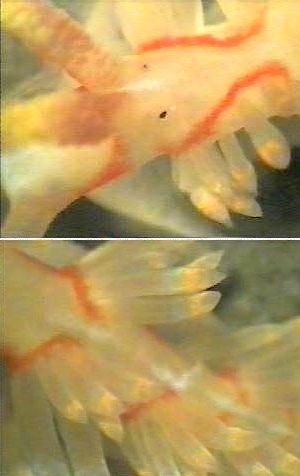
Berghia rissodominguezi
Muniain & Ortea, 1999
Order: NUDIBRANCHIA
Superfamily: AEOLIDINA
Family: Aeolidiidae
DISTRIBUTION
Known only from the western Atlantic from Florida south to Patagonia.
PHOTO
Santa Marta region, Colombia (Caribbean) in less than 1m. Approx 8mm long. Photo: Elianny Dominguez.
I have copied here the part of the original description dealing with the external features:
Animal thin and elongate, 52 mm in length. General body colour translucent white. There are oblique bright orange lines on the borders of the insertion of the cerata and in front of the rhinophores. Over the head and between the rhinophores is an orange triangle. Translucent ceras with central reddish-brown diverticulum, ending in a short white cnidosac. An orange band with a thin subapical red ring around it are present. The digestive gland forms a brown-red dorsal digestive mid-dorsal line, visible through the mantle surface from the third group of cerata back to the last cerata. Rhinophores are long, tuberculate on the lateral and posterior sides, with cream-white coloration and yellow on apical portion. The translucent oral tentacles have a wide area of the same yellow colour covering two-thirds of them. The tentacles are long and slender and approximately twice as long as the rhinophores. Cerata cylindrical and elongate with a rounded apex, uniform in diameter throughout most of their length. There are 6-8 clusters of cerata on each side, containing between 3 to 24 cerata per arch. The anteriormost cluster shows the greatest number of cerata 21-24 (Holotype) and the most curved shape, decreasing in number and length towards the tail. The posterior 1-2 clusters consist of rows 1-3 cerata. The inconspicuous renopericardical prominence is situated between the first and second cerata arches, which are further apart than the others. Foot grooved anteriorly, with elongated foot corners and tapering gradually towards the tail.
Muniain & Ortea (1999) list a number of earlier records of this species which have been previously misidentified. From my own check of the literature, the following clearly refer to this species: Marcus, 1957, as Berghia coerulescens from Brazil; Marcus & Marcus, 1959, as B. coerulescens from Texas; Marcus, 1972, as Berghia verrucicornis from Florida; Thompson, 1980, as B. verrucicornis from Jamaica.
See message from Colombia showing very characteristic orange markings around the ceratal insertion points, and details of eggs and larval development.
References:
• Marcus, Er (1957): On Opisthobranchia from Brazil (2). Journal of the Linnean Society of London, Zoology 43(292): 390-486.
• Marcus, Ev. & Marcus, Er (1960) Some opisthobranchs from the northwestern Gulf of Mexico. Publications Institute Marine Science, University Texas, 7: 251-261. (Pls.1-3)
• Marcus, Ev (1972) On some opisthobranchs from Florida. Bull. Mar. Sci., 22(2): 284-308.
• Muniain, C. & Ortea, J. (1999). First records of the genus Berghia Trinchese, 1877 (Opisthobranchia: Aeolidiidae) from Argentina, with description of a new species. Avicennia, 10-11: 143-150
• Thompson, T.E. (1980) Jamaican opisthobranch molluscs: II Journal of Molluscan Studies, 46(1): 74-99.
Rudman, W.B., 2003 (October 15) Berghia rissodominguezi Muniain & Ortea, 1999. [In] Sea Slug Forum. Australian Museum, Sydney. Available from http://www.seaslugforum.net/find/bergriss
Related messages
Re: Berghia columbina? from the Gulf of Mexico
February 11, 2004
From: Lynn Zurik
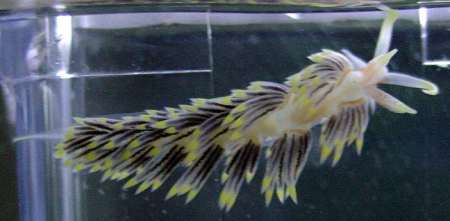
Dear Bill,
Thanks so much your help. I'm sending another photo that shows the orange coloration better along the body. As far as size goes, all stretched out on the glass, this aeolid's about 1" long. Cruising around on the rock, it's more like 5/8"-3/4".
Unfortunately, this is the only one I've seen so far. I wish they shipped better, as I would love to send this guy to someone that was breeding them!
Thanks again,
Lynn
l.zurik@verizon.net
Zurik, L., 2004 (Feb 11) Re: Berghia columbina? from the Gulf of Mexico. [Message in] Sea Slug Forum. Australian Museum, Sydney. Available from http://www.seaslugforum.net/find/12167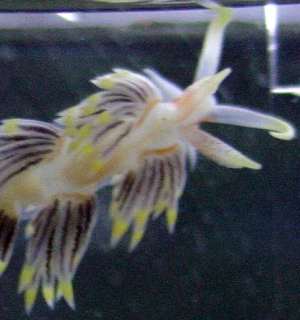
Thanks Lynn,
You can certainly see the orange lines in this photo and also the orange and yellow bands on the rhinophores, whicn certainly appear to have papillae on the posterior edge. I guess it's a question now whether others agree with my view that B. columbina and B. rissodominguezi are the same thing.
Best wishes
Bill Rudman
Berghia rissodominguezi = B. columbina
February 9, 2004
From: Bill Rudman
Last year I identified a species of aeolid from the Caribbean as Berghia rissodominguezi [see #11258], a species considered endemic to the western Atlantic. In their original description, the authors (Muniain & Ortea, 1999) compare their species with other aeolidiids described from all parts of the Atlantic, discuss the phenomenon of amphiatlantic species, and conclude they have a new species, endemic to the west Atlantic.
However they seem to have missed Spurilla columbina Garcia-Gomez & Thompson, 1990, a species described from, and known only from the Andalusian coast of Spain. This species agrees in all material points of the colour pattern, external shape and internal anatomy. To keeps things uncomplicated, I follow Miller (2001) in placing species such as Spurilla columbina, with papillate rhinophores, in the genus Berghia.
If I am correct, Berghia columbina, rather than being a Spanish endemic, would appear to be an amphiatlantic species with a wide distribution also in the western Atlantic. It is fitting that this species, which was named to commemorate Christopher Columbus's first European contact with the Americas, may have been travelling across the Atlantic itself, many years before we found out how to.
Before I make the necessary changes on the Forum, I would be grateful for any comments for or against this proposed synonymy.
References:
• Miller, M.C. (2001) Aeolid nudibranchs (Gastropoda: Opisthobranchia) of the family Aeolidiidae from New Zealand waters. Journal of Natural History, 35(5): 629-663.
• Garcia-G¢mez, J.C. & Thompson, T.E. (1990) North Atlantic spurillid nudibranchs, with a description of a new species, Spurilla columbina, from the Andalusian coast of Spain. Journal of Molluscan Studies, 56: 323-331.
• Muniain, C. & Ortea, J. (1999). First records of the genus Berghia Trinchese, 1877 (Opisthobranchia: Aeolidiidae) from Argentina, with description of a new species. Avicennia, 10-11: 143-150
Best wishes
Bill Rudman
Berghia columbina? from the Gulf of Mexico
February 9, 2004
From: Lynn Zurik
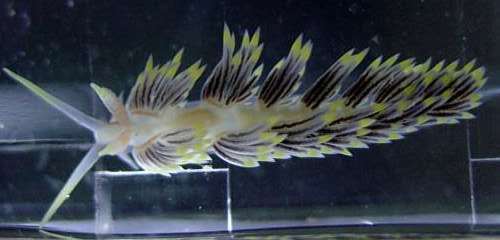
Hi Bill,
I'm trying to figure out which species this is. This little guy hitchhiked in on some live rock from the Gulf of Mexico. I had had the rock for almost 2 months before I even saw him. Thankfully, he's all but taken care of the Aiptasia that also came with the rock. Thank you so much for you help.
Lynn Zurik
l.zurik@verizon.net
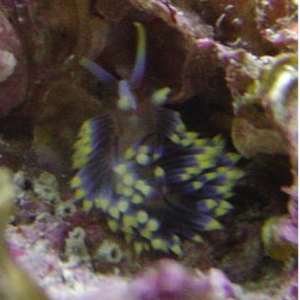
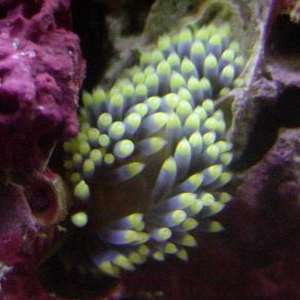
Dear Lynn,
By an amazing coincidence I prepared a message yesterday, for posting today, [see #12149] suggesting that the Spanish aeolid Berghia columbina was almost certainly the same as the Caribbean Berghia rissodominguezi. And today I get your message which is certainly about an adult of this species. I would be very interested in some idea of the length of your animal.
We don't know very much about this species, but it seems the most characteristic external feature is the orange curved lines that run along the inside base of each group of cerata. The lines are not that clear in your photo but they are definitely there. It is not unusual in aeolids to see colour markings varying in intensity, perhaps it needs pigment from the anemones it feeds on to enhance its colour pattern. Other distinguishing points are the papillate rhinophores with a yellow upper half and an orange lower band. The animals we already have illustrated on the Forum are most probably juveniles, but like your animal, they have indications of a subterminal yellow band on the cerata.
When I first saw your photos I thought this aeolid was a glaucid of some sort, but your mention that it had helped solve your Aiptasia problem suggests that it is a member of the Aeolidiidae, a family which specialises on eating sea anemones. It's a pity you have only one animal because it would be nice to see whether this was a species which could be captive bred in aquaria. Have a look at the page I have on the species of Berghia which has become a sought after saviour of Aiptasia infested aquaria. It is one nudibranch which can be captive bred.
What should you call your animal? I am pretty sure that the Spanish animal, Berghia columbina, is the same as the Caribbean B. rissodominguezi, so as Berghia columbina is 9 years older, it is the name we should use. Before changing names on the Forum however, I am giving colleagues the opportunity to discuss the matter.
Thanks for the photos,
Best wishes
Bill Rudman
Berghia rissodominguezi from Colombia
October 17, 2003
From: Bill Rudman
I am happy to announce that I have found a name for one of the 'lost souls' in the 'unidentified pages'. An aeolid from Colombia with very characteristic orange markings around the ceratal insertion points, is Berghia rissodominguezi. The relevant article was in a set of photocopies that Colin Redfern kindly sent to me.
According to Muniain & Ortea (1999), some of the records of Berghia coerulescens and Berghia verrucicornis from the Caribbean as misidentifications for this species.
• Muniain, C. & Ortea, J. (1999) First records of the genus Berghia Trinchese, 1877 (Opisthobranchia: Aeolidiidae) from Argentina, with desription of a new species. Avicennia, 10/11: 143-150.
Bill Rudman
Rudman, W.B., 2003 (Oct 17) Berghia rissodominguezi from Colombia. [Message in] Sea Slug Forum. Australian Museum, Sydney. Available from http://www.seaslugforum.net/find/11258Flabellina? from Colombia
September 14, 2001
From: Elianny Dominguez Tejo

Hi Dr. Rudman,
We finally got some good pictures of this nudibranch. We had good luck with this one since it laid an egg mass on our aquarium and we got to see the larvae swimming around. It was found in the Santa Marta region of Colombia (Caribbean) in less than 1m. It is about 8mm long.
The rhinophores are yellow with purple on the base, and they have papillae. Another distinctive feature are the red lateral lines along the body, surrounding the ceratal clusters.
Concerning the eggs: In A you can see the egg mass on Ulva sp. In the other photos you can see the larvae. In C, just outside the egg mass (on the top of it), there is one free larvae, we believe it was the first one to make it out. It looks like a dark capsule. We actually have it on video tape and they move quite fast. We taped them over a period of about 5 hours, and we got to see some of them swimming free on the water.
Best regards,
Elianny Dominguez.
elicelotte@latinmail.com

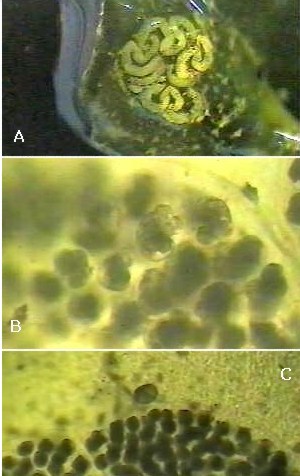
See Oct 16 2003 message showing this is Berghia rissodominguezi.
Dear Elianny,
These are interesting photos and the orange lines outlining the ceratal clusters should make this animal readily identifiable. Marcus describes an animal with orange curves like this from Brasil (Marcus, E., 1957 -as Berghia coerulescens) and Florida (Marcus, Ev., 1972 - as Berghia verrucicornis). The animals from Florida seem very similar in colour to yours while the Brazilian ones had red rings on the cerata.
I don't know if Marcus' species is really B. verrucicornis or if your animal is really the same. As a first step I think you will need to do a bit of anatomy. If you were able to look at the radula it would remove much of the guess-work from identifying your animals. If I knew the shape of the teeth I should be able to put your species into a genus at least which would make it much easier to know if your animals have a name or not. Do you know how to remove and study the radula? If not let me know and I can give you some background information.
• Marcus,Er (1957) On Opisthobranchia from Brazil (2). Journal of the Linnean Society of London, Zoology, 43(292): 390-486.
• Marcus, Ev (1972) On some opisthobranchs from Florida. Bull. Mar. Sci. 22(2): 284-308.
Best wishes,
Bill Rudman
